As one of the country’s oldest and most deeply rooted land-grant institutions, Kansas State University has made a positive impact on communities near and far. Through K-State Research and Extension, Kansas State has a rich history of service to communities all across the state of Kansas, and that commitment to service continues to expand and grow through community engagement activities throughout the university. The K-State 2025 Strategic Action Plan recognizes external engagement, extension, outreach, and service as, "core to our value and identity as a public research land-grant university contributing to the public good." The plan (pdf) envisions engagement activity as synergistic with other research and education efforts. In addition, it creates university-wide networks to support engagement efforts across all colleges and departments and establishes tools to measure and document K-State’s engaged work and its impacts. As a result, educators, researchers, and engagement specialists are hard at work across the campuses of K-State, the state of Kansas, and beyond to elevate their impact and carry out the land-grant mission of Kansas State University.
The Association of Public and Land Grant Universities defines engagement (pdf) as, “the partnership of university knowledge and resources with those of the public and private sectors to enrich scholarship, research, and creative activity; enhance curriculum, teaching, and learning; prepare educated, engaged citizens; strengthen democratic values, and civic responsibility; address critical societal issues; and contribute to the public good." Engagement emphasizes campus and community partnerships where groups collaborate on critical issues in reciprocal, mutually beneficial ways. To develop more extensive and effective partnerships, K-State established the Center for Engagement and Community Development—a university-wide resource dedicated to providing value to both university and off-campus communities through expanded outreach and engagement.
“Kansas State University is truly an engaged university,” said David Procter, director of the Center for Engagement and Community Development. “Connecting the university’s work to the citizens of Kansas has been part of our identity since our beginning in 1863. And today, this work is stronger than ever as demonstrated in a 2015 campus engagement benchmarking survey,” said Procter. This article shares some of the data collected by the survey and highlights projects in three separate areas where K-Staters are making an impact on the future of Kansas citizens and communities.
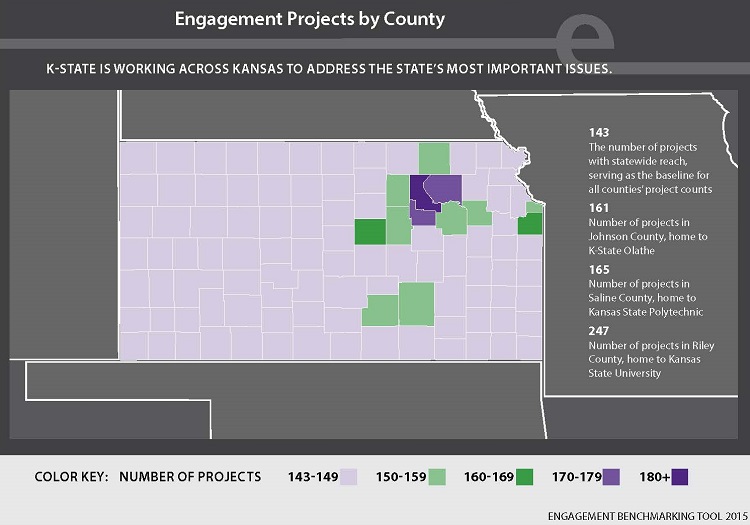
This map shows the Kansas counties engaged by K-State and the number of projects in each, including high engagement in the counties with K-State campuses. K-State’s first EBT survey (pdf) was conducted in 2013, and the most recent results (pdf) from the 2015 EBT were recently released by the Center for Engagement and Community Development. It provides a snapshot, in numbers, of K-State’s engagement activity, including number of K-State faculty and staff who are engaged and where they are making an impact.
The Engagement Benchmarking Tool (EBT) is a voluntary, self-reported online survey of faculty and academic staff regarding their scholarly outreach and engagement. Data collected through the K-State EBT demonstrate the university’s collective commitment of time, scholarly resources, and research discoveries for the direct benefit of citizens, communities, and organizations in Kansas and communities worldwide. It benchmarks the university’s progress toward Theme Four of K-State’s visionary 2025 plan, gathers data for reaccreditation of the Carnegie Foundation’s community engagement classification, and provides data used for reporting to the Kansas Board of Regents and the Higher Learning Commission.
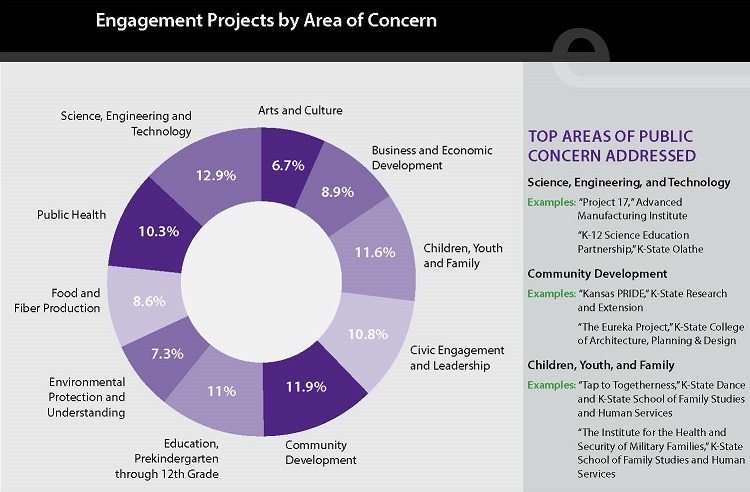
This graph shows the areas of public concern that are currently being addressed by K-State's engagement efforts. The top three areas of public concern being addressed by K-State's engagement work are listed to the right of the graph, along with some project examples from each area.
The 2015 EBT showed the involvement of more than 270 faculty, over 900,000 citizens (not counting the additional contributions of K-State Research and Extension projects), more than 60 K-State classes using a service-learning teaching pedagogy, and over 9,000 undergraduate and graduate students. Faculty and staff secured more than $18 million in grants and contracts to support their engaged work, and there were more than 240 engaged projects in Riley County and over 160 engaged projects in both Johnson County (home to K-State Olathe) and Saline County (home of Kansas State Polytechnic).
The 2015 EBT data showed that the top three areas of public concern that are being addressed by K-State’s engaged work are: Science, Engineering, and Technology; Community Development; and Children, Youth, and Families. “Behind these general numbers are real faculty and staff, working with real community partners, to address real challenges,” said Procter.
Science, Engineering, and Technology
“Project 17: A Change Platform for Large-Scale Regional Economic Development and Community Engagement,” has engaged 17 counties in southeast Kansas to help improve the economic development, education, workforce, health, and leadership of each community. Since its launch in 2012, the collective influence of Project 17 and its partners has engaged more than 1,800 citizens, trained more than 1,000 leaders, leveraged $25.54 million in private investment, assisted 194 businesses, engaged 107 entrepreneurs, retained 431 jobs, and created 674 new jobs.
The Project 17 region has experienced concentrated poverty and unemployment rates significantly higher than the state average and public health indicators that are chronically among the poorest in the state. Additionally, 10 of the region’s 17 counties have insufficient access to the high speed internet connectivity required to support business growth, education, and health care at an affordable cost, with only a low percentage of the region’s businesses having a website and even fewer participating in e-commerce. “We are motivated to help ensure that southeast Kansas prospers, and also that K-State students have the opportunity to work in rural spaces,” said Heather Morgan, the project’s executive director. “Project 17 exposes them to a region many of them had never visited.”
The Advanced Manufacturing Institute (AMI), within Kansas State University’s College of Engineering, has been supporting innovation-based economic development initiatives in rural regions and communities of Southeast Kansas since 2011. With collaboration from a wide array of partners—including the US Department of Agriculture-Rural Development, the US Economic Development Administration, the Kansas Department of Commerce, the Kansas Leadership Center, Casey Family Programs, the Kansas Department of Children and Families, faith-based groups, and other community organizations—AMI is working to develop and deploy network-based strategies, tools, and resources to assist Kansas rural communities, businesses, and citizens to improve their lives, communities, and economic competitiveness in the global economy.
In addition to collaboration with Pittsburg State University and Wichita State University, AMI has engaged students, faculty, and staff across Kansas State University in the College of Business, the College of Agriculture, the College of Architecture, Planning, and Design, College of Human Ecology, College of Arts and Sciences, and the Staley School of Leadership Studies.
Rather than a traditional top-down driven change program, Project 17 is a grassroots-supported platform that enables all citizens to participate through active recruitment of volunteers and partners to tackle complex problems within their communities. “Project 17 is unique because it’s a grassroots approach,” said Morgan. “It’s about the region’s citizens identifying needs and putting solutions in place.”
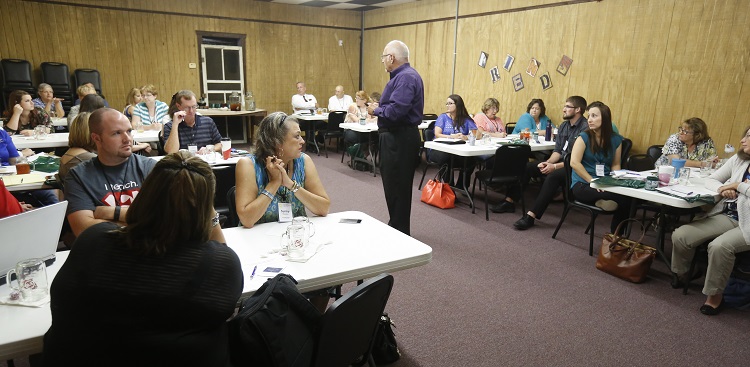
Project 17 leaders have conducted 13 workshops across Southeast Kansas. Ron Alexander of the Kansas Leadership Center told attendees at a workshop in Woodson County that Project 17 will continue to improve if residents and community partners keep pressing on to achieve the best for their region. “Each person living in the Project 17 region must exercise leadership every day to bridge the gap between our current situation and our aspirations,” Alexander said. “Project 17 is here to support, encourage, and work alongside you to make southeast Kansas the best place it can be.”
Community Development
Todd Gabbard, associate professor, director of graduate programs, and associate department head for the architecture department in the College of Architecture, Planning, and Design, is fascinated by the small rural towns that define Kansas. Since 2012, the town of Eureka, Kansas has served as a cornerstone for Gabbard’s fifth-year architecture design studio. Students in the studio dedicate their entire year to community engagement. During the fall semester, they conduct research and interact with local townspeople to determine what kind of project would best benefit the town, and they work to implement those projects in the spring. “The idea is having students go out into the community. Instead of talking to me or other people in the architecture department, they now have to convey their ideas to somebody else. That’s why it’s a good educational model,” Gabbard said.
The goal of the Small Town Studio is to engage rural communities across Kansas with student-generated design and visualization services. Since its inception, the Small Town Studio has provided design services to six Kansas communities, including Cuba, Pittsburg, Blue Rapids, Jamestown, and Colby. The Studio has partnered most prominently with the city of Eureka, where more than a dozen projects have been pursued. The Eureka Foundation provided financial support to the Small Town Studio’s local presence, Eureka Studio. The Eureka Studio has grown to become a rural community design center and co-working studio located with the non-profit Bluestem ARTS Initiative Inc. As a result, the town has reinvested in Main Street, passing a plan to revitalize the downtown area, and a number of new businesses have moved in.
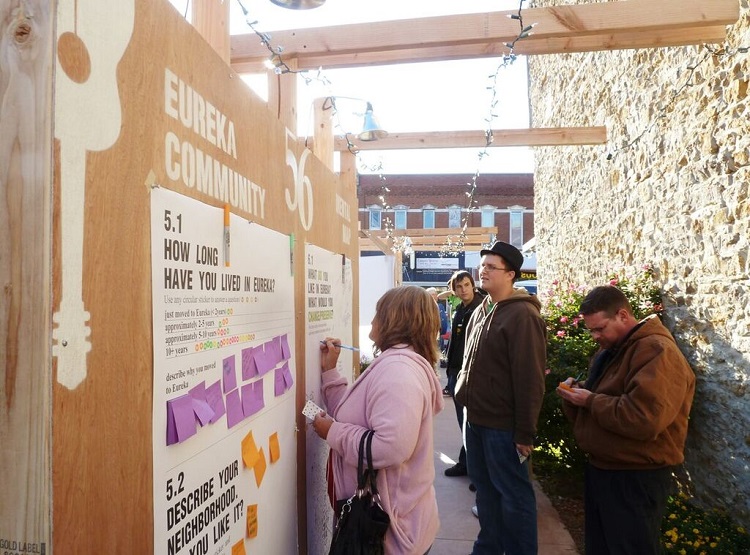
Residents of Eureka, Kansas participate in a community survey project to assist with planning and design efforts of the Small Town Studio.
Over the multiple years of engagement, issues and projects have been developed through an engaged process of workshops, events, and other forms of community input combined with extensive research, expert consultation, and input from faculty and other reviewers. Once projects are ratified by the community, students are responsible for moving the project towards realization, which may include activities such as securing permissions, permitting, grant writing or other fundraising. "Architecture impacts people and communities," said Gabbard. "Designers cannot ignore place, culture, and people as individuals. Design must embrace them."
"In 2010, locals referred to Eureka as a 'dying town,' not with anger or sadness, just an eerie resolve," said Larry Coleman of Eureka, who has worked with the Small Town Studio since the fall semester of 2012. "Each year, the students bring a wealth of knowledge, unbridled enthusiasm, and an unstoppable energy," Coleman said. "It challenges people to think of possibilities."
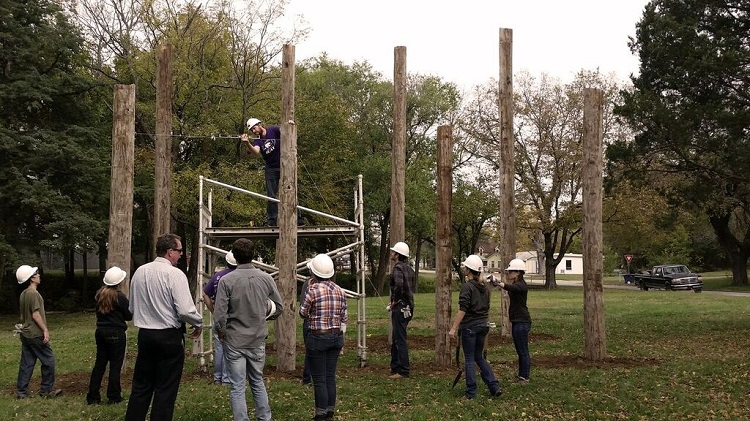
Students designed and oversaw the construction of a new pavilion in Eureka’s Founder's Park, which was completed in the fall of 2015. “I don’t think they thought at the beginning that it was a big deal. They thought, ‘We’ll just make the posters and send a couple of us down there to go talk to them,’” Gabbard said. “But while they were waiting to go in and deliver this project, they got nervous. At that moment they realized they were acting as architects for the first time in the real world, doing something a real architect would do, and their design was going to have a real impact.”
Children, Youth, and Families
Kansas State faculty actively seek ways they can use their skills, passions, and expertise to serve as a gateway to change in the community and beyond. Julie Pentz, Associate Professor of Dance, had a clear vision for strengthening the bonds of families through tap dance. She shared her vision and expertise with Bradford Wiles, Assistant Professor in the College of Human Ecology and Extension Specialist, and Parent Educator Janice Schroeder. Pentz, Schroeder, and Wiles, or the T3 team, combined their skills and passions to create the engagement incentive grant proposal, Tap to Togetherness.
Tap to Togetherness began in the spring of 2015 and strives to bring families together through rhythm, music, and laughter. “Adding this program fits perfectly with K-State’s 2025 vision,” Wiles said, “There just nothing quite like helping families learn to have fun together, learn a new skill, and really to build that family resilience.”
Participants attend tap dance sessions bi-weekly, and the program is aimed to engage children ages 12 months to pre-Kindergarten. The sessions are offered through K-State Research and Extension and a local Parents as Teachers Program. While the program helps to unite families, it also helps K-State undergraduate students conduct research. The tap lessons are supported by research-based strategies that help to stimulate social, cognitive, and physical development.
Tap Togetherness leverages the expertise from K-State’s dance professors and faculty from other facets of the university to construct impactful opportunities to serve families within the community. The T3 team plan to increase their impact and offer classes around the state, nation, and world. The team also plans to develop a mobile application to stay connected to families who have participated and also to make the program more accessible.
This video highlights some of the students, faculty, and community participants who are engaged in Tap to Togetherness. This work has helped the participants and brought unique, invaluable learning experiences to the current K-State students involved.
Each project is an example of an issue or community where K-State’s engagement is making a real difference. Each year, the Center for Engagement and Community Development celebrates extraordinary engagement activity through the Excellence in Engagement Awards. Since it was established in 2012, ten projects have received the award, which includes $2,500 to support continued partnership and engagement. Applications for the 2017 Excellence in Engagement Award are now open, and materials are due by February 1st. “The award has been a great opportunity to recognize some of the amazing faculty conducting work that engages society in a collaborative fashion to address and solve socially significant challenges,” said Procter.
“Engagement is easier than you might think,” said Todd Gabbard, professor in the Department of Architecture and founder of the Small Town Studio initiative. “If you are a faculty member interested in engagement across Kansas, you are at the right university.”
According to the Engagement Benchmarking Tool, the university increased its impact on Kansans (not counting K-State Research and Extension projects) and citizens worldwide from 265,587 in 2013 to 907,262 citizens in 2015. Through K-State 2025, the university seeks to become, “a national leader and model for a re-invented and transformed public research land-grant university integrating research, education, and engagement.” With this goal in mind, and the momentum established over the first five years of the plan, Kansas State University will continue to build collaborative partnerships and elevate its impact on communities near and far.
